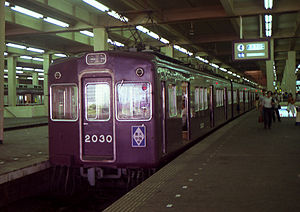You can help expand this article with text translated from the corresponding article in Japanese. (March 2019) Click for important translation instructions.
|
| This article needs additional citations for verification. Please help improve this article by adding citations to reliable sources. Unsourced material may be challenged and removed. Find sources: "Hankyu 2000 series" 1960 – news · newspapers · books · scholar · JSTOR (January 2021) (Learn how and when to remove this message) |
| Hankyu 2000 series | |
|---|---|
 A 2000 series at Umeda Station A 2000 series at Umeda Station | |
| In service | 1960–2013 |
| Manufacturer | Naniwa Kōki |
| Family name | Auto Car |
| Number built | 114 vehicles |
| Number in service | 9 vehicles (mixed 3000 series) |
| Number preserved | 2 vehicles |
| Operators | Hankyu Railway |
| Specifications | |
| Car body construction | Steel |
| Doors | 3 pairs per side |
| Maximum speed | 110 km/h (70 mph) |
| Traction system | Resistor control |
| Electric system(s) | 600 V DC, later 1,500 V DC overhead catenary |
| Current collector(s) | Pantograph |
| Braking system(s) | Regenerative brake (originally) Dynamic brake Electro-pneumatic brake |
| Safety system(s) | ATS |
| Coupling system | Knuckle-Type |
| Track gauge | 1,435 mm (4 ft 8+1⁄2 in) |
The Hankyu 2000 series (阪急電鉄2000系) was an electric multiple unit (EMU) train type operated in Japan by the private railway operator Hankyu Railway since 1960. It was the recipient of the inaugural Laurel Prize presented by the Japan Railfan Club in 1961.
Variants
The 2000 series included the following types.
- 2021 series (later reclassified 2071 series)
- 2100 series
Interior
Passenger accommodation consisted of longitudinal bench seating throughout.
Withdrawal and resale
The 2100 series trains were withdrawn between 1983 and 1985, and four-car sets were sold to the Nose Electric Railway, classified as 1500 series. The 2000 series trains were withdrawn between 1989 and 1992, and four-car sets were sold to the Nose Electric Railway, classified as 1700 series.
References
- Harris, Ken, ed. (2005). Jane's World Railways 2005-2006 (47th ed.). Jane's Information Group. p. 291. ISBN 0-7106-2710-6.
- "ブルーリボン賞・ローレル賞" [Blue Ribbon Award・Laurel Prize]. jrc.gr.jp (in Japanese). Japan Railfan Club. Archived from the original on 22 August 2016. Retrieved 17 June 2020.
| Hankyu trainsets | ||
|---|---|---|
| Kobe/Takarazuka Lines |  | |
| Kyoto Lines | ||
| Withdrawn | ||

